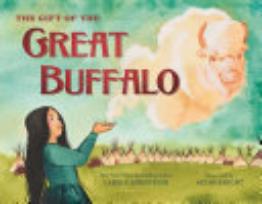Lindstrom, Carole
4 Reviews
(2)
K-3
Illustrated by
Aly McKnight.
Rose, her oshiimeyan (younger sister), and their parents gather with other Métis families for the biannual buffalo hunt. This time will be different both because Rose's pa is one of the hunt's captains and because "the settlers and their iron horses had eliminated most of the buffalo"; the accompanying illustration shows Rose saying a "prayer of gratitude to the buffalo" while a train churns out black smoke, turning the blue sky gray. When scouts are unable to find buffalo after a week, Rose decides to look for them on her own. Her cleverness and bravery lead to success for the whole community. Lindstrom's (Autumn Peltier, Water Warrior, rev. 11/23) engaging text is well paired with McKnight's expansive, atmospheric watercolor and graphite illustrations. Back matter adds useful context; for example, in her appended note, Lindstrom says: "Rose's story is my version of the Little House series. So readers will know that before there was a little house on the prairie, there was a little tipi on the prairie...on the same land where the Little House stories were set." Important terms are defined, and a history of the buffalo hunt is provided. This Métis/Ojibwe perspective of life on the prairie by two Native creators is a moving tribute to a culture and people.
Reviewer: Nicholl Denice Montgomery
| Horn Book Magazine Issue:
March, 2025
(1)
K-3
Illustrated by
Steph Littlebird.
"Our ancestors say / Our hair is our memories. / Our source of strength." Lindstrom's (author of Caldecott winner We Are Water Protectors, rev. 7/20, and an enrolled citizen of the Turtle Mountain Band of Ojibwe) authentic storytelling text explains the importance of hair--"Native/Indigenous peoples believe that hair holds strength and power"--and its connection to Mother Earth. An Indigenous girl is eager for her hair to grow. She tells us that her mom kept her own hair short because she was told as a child it was "too wild." Nokomis (her grandmother) had long hair, but it was cut off at the Indian boarding school she was forced to attend as a child. The text follows the girl as her hair grows longer and longer: "When Nimishoomis taught me / how to fish for the first time, / my hair was at my ears"; "When my baby brother was born, / my hair touched my shoulders." The intergenerational interaction of family highlights the idea many Indigenous families have that future generations can reclaim what was lost. The narrative's powerful ending brings this story to a satisfying, hopeful conclusion. Debut illustrator Littlebird (a member of Oregon's Confederated Tribes of Grand Ronde) captures the closeness of the family and the strength and determination of the protagonist in bright colors set against woodgrain-like backgrounds. Subtle visual cues in the characters' facial expressions enable viewers to distinguish emotions as well as depicting the beauty and honor long hair holds for Indigenous people. Appended with an author's note and a short glossary of Ojibwe words.
(2)
K-3
Illustrated by
Bridget George.
Lindstrom (We Are Water Protectors, rev. 7/20; My Powerful Hair, rev. 3/23) introduces the mission of contemporary Indigenous water activist Autumn Peltier and her great-aunt, the late Josephine Henriette Mandamin (both Anishinaabe). The lyrical text, narrated by water itself ("I am nibi. I have a spirit. I have feelings. I remember"), is effective in its simplicity and highlights the belief that water is a living thing that needs us to "Speak for the water. Sing for the water. Dance for the water." Grandma Josephine ("as she was lovingly known") recognized the harmful effects of water pollution in the Great Lakes, and she took action. To raise awareness, she walked around the lakes carrying water in a copper pail and united women from other Indigenous communities--now known as the Mother Earth Water Walkers--to join the water protection movement and inform government leaders. "When Grandma Josephine journeyed on to the spirit world, Autumn...began to use her voice for me." The colorful, flowing illustrations beautifully reflect and depict the nature of water. Peltier provides the book's foreword; back matter includes more detailed information about Grandma Josephine's and Autumn's accomplishments, a glossary, and resources to "keep learning."
(2)
K-3
Illustrated by
Michaela Goade.
The book opens with a young Indigenous girl collecting water with her grandmother, who tells her that "water is the first medicine." Vibrant blues, greens, and purples depict the river as it flows in the background of the beautifully composed spread. The river then flows onto the next spread, encircling a mother and her unborn child. The water "nourished us inside our mother's body. As it nourishes us here on Mother Earth." With every page-turn, the river continues to flow; it becomes the young girl's hair as she leads members of her community to where the "black snake" threatens to take over their land and water. The refrain "We stand / With our songs / And our drums / We are still here," which punctuates and strengthens the main text, is printed in italics and can easily be read as the voice of the community come together. The book closes with members of multiple Native communities united at Standing Rock to stop the "black snake." Back matter includes more information about water protection and Standing Rock; a glossary of Ojibwe, Tlingit, and Lakota words; an illustrator's note; and an "Earth Steward and Water Protector Pledge."
Reviewer: Nicholl Denice Montgomery
| Horn Book Magazine Issue:
July, 2020
4 reviews
We are currently offering this content for free. Sign up now to activate your personal profile, where you can save articles for future viewing.








